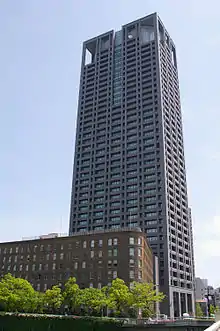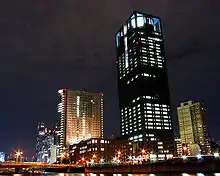Kansai Electric Power Company
The Kansai Electric Power Company, Incorporated (Japanese: 関西電力株式会社, Kansai Denryoku kabushiki gaisha, KEPCO), also known as Kanden (関電), is an electric utility with its operational area of Kansai region, Japan (including the Keihanshin megalopolis).
 | |
Native name | 関西電力株式会社 |
|---|---|
Romanized name | Kansai Denryoku kabushiki gaisha |
| Type | Public (Kabushiki gaisha) |
| Industry | Electric utility |
| Predecessor |
|
| Founded | Osaka, Japan (1 May 1951) |
| Headquarters | Nakanoshima, Kita-ku, Osaka, Japan |
Area served |
|
Key people |
|
| Products | Electrical power |
| Revenue | |
| Total assets | |
| Total equity | |
| Owner |
|
Number of employees | 32,961 (consolidated, as of 31 March 2012) |
| Subsidiaries |
|
| Website | www |
Footnotes / references
| |

The Kansai region is Japan's second-largest industrial area, and in normal times, its most nuclear-reliant. Before the Fukushima nuclear disaster, a band of 11 nuclear reactors – north of the major cities Osaka and Kyoto – supplied almost 50 percent of the region's power. As of January 2012, only one of those reactors was still running.[1] In March 2012, the last reactor was taken off the powergrid.
Power plants
Kansai Electric Power Company has 164 plants with a total production capacity of 35,760 MW.
Nuclear
| Name | Location | Generation capacity (MW) |
|---|---|---|
| Mihama | Fukui | 1,666 |
| Ōi | Fukui | 4,710 |
| Takahama | Fukui | 3,392 |
Thermal
| Name | Generation capacity (MW) |
|---|---|
| Akō | 1,200 |
| Aioi | 1,125 |
| Himeji-1 | 1,442 |
| Himeji-2 | 2,550 |
| Takasago | 900 |
| Nanko, Osaka | 1,800 |
| Maizuru | 900 |
| Gobō Thermal Power Plant | 1,800 |
| Sakai | 2,000 |
| Tanagawa, Misaki | 1,200 |
| Kainan | 2,100 |
| Miyazu | 750 |
Hydro
| Name | Generation capacity (MW) |
|---|---|
| Kurobe-4 (Kurobe Dam) | 335 |
| Others (147 plants) | 818 |
Accidents and incidents
Mihama accident in 2004
On 9 August 2004, KEPCO reported that five of its employees were killed by a steam burst in the turbines housing building, at the Mihama Nuclear Power Plant in Fukui Prefecture. The burst, according to KEPCO, was due to the neglect of mandated safety checks and there was no release of radioactivity.
2006
On 22 March 2006, in Ōi Nuclear Power Plant, at the waste incineration facility area, where ash is packed in steel barrels, a fire broke out. Two workers were admitted to a hospital after inhaling smoke, but not in critical condition. No radiation leakage was monitored.[2]
2011 aftermath
The Kansai region is Japan's second-largest industrial area, and in normal times, its most nuclear-reliant. Before the Fukushima nuclear disaster, a band of 11 nuclear reactors – north of the major cities Osaka and Kyoto – supplied almost 50 percent of the region's power. But as of January 2012, only one of those reactors is still running. Meanwhile, power company employees are racing to reassure Japanese that plants are safe and necessary. In 2012, officials from Kansai Electric Power Co., "have gone door to door in towns that host its nuclear plants, conducting polls and answering questions".[1]
Corruption scandal
Eiji Moriyama, the former deputy mayor of Takahama now deceased, was the primary "fixer" between Kepco and businesses in Takahama. Beginning as early as 1987, Moriyama was a conduit for funneling cash and gifts to Kepco officials in exchange for kickbacks and contracts to real estate and construction-related firms. Moriyama received "consulting fees" for his help.[3]
The earliest indication of the corrupt relations between Kepco and local businesses appeared in a report from the taxation authorities, regarding unreported income on "idle lands".[4][5] This was followed by a report in 2011 that Kepco had sold scrap metal to a local company at below market value.[6]
In 2012 it was revealed that a member of the town assembly of Takahama, Fukui, Tomio Yamamoto, had received as president of the real estate company OHC Fukui, over 100 million yen for the rent of an unused factory over four years from 2006 to 2010 from a subsidiary of Kansai Electric Power Co. (KEPCO) The factory was used for storage, but the rent was unusually high, almost double the market price. The money was apparently paid in return for promoting nuclear power. In September 2010 an opinion statement to reactivate the nuclear reactors was proposed by Akio Awano, the vice speaker of the town assembly. Yamamoto and two other town assembly members did sign the proposal before it was submitted to the assembly.[7]
In 2014, the Ministry of Economy, Trade and Industry cited Kepco for restraint of trade (社宅) in the purchase of transmission line equipment. After review, 240 employees were found to have been involved in the price rigging, and the company dismissed four vice presidents and four executive officers.[8]
Overall, more than 380 cases were discovered where money and gifts had been exchanged for the awarding of contracts to businesses connected to Moriyama, including pay-outs to board members and the company's president. In response to these revelations, Kepco Chairman Makoto Yagi resigned in 2019, and Kepco president Shigeki Iwane resigned in 2020.[3] Takashi Morimoto, executive vice president, became the new president.[9]
Opposition to the dependence on nuclear power
In August 2011 citizens of the prefecture Shiga, at the banks of Lake Biwa, started a lawsuit at the Otsu District Court, and asked a court order to prevent the restart of seven reactors operated by Kansai Electric Power Company, in the prefecture Fukui.[10]
On 27 February 2012 three Kansai cities, Kyoto, Osaka and Kobe, jointly asked Kansai Electric Power Co. to break its dependence on nuclear power. In a letter to KEPCO they also requested to disclose information on the demand and supply of electricity, and for lower and stable prices. The three cities were stockholders of the plant: Osaka owned 9% of the shares, while Kobe had 3% and Kyoto 0.45%. Toru Hashimoto, the mayor of Osaka, announced a proposal to minimize the dependence on nuclear power for the shareholders meeting in June 2012.[11]
On 18 March 2012 the city of Osaka decided as largest shareholder of Kansai Electric Power Co, that at the next shareholders-meeting in June 2012 it would demand a series of changes:
- that Kansai Electric would be split into two companies, separating power generation from power transmission
- a reduction of the number of the utility's executives and employees.
- the implementation of absolutely secure measurements to ensuring the safety of the nuclear facilities.
- the disposing of spent fuel.
- the installation of new kind of thermal power generation to secure non-nuclear supply of energy.
- selling all unnecessary assets including the stock holdings of KEPCO.
In this action Osaka had secured the support of two other cities and shareholders: Kyoto and Kobe, but with their combined voting-rights of 12.5 percent they were not certain of the ultimate outcome, because for this two-thirds of the shareholders would be needed to agree.to revise the corporate charter.[12]
At a meeting held on 10 April 2012 by the "energy strategy council", formed by the city of Osaka and the governments of the prefectures, it became clear that at the end of the fiscal year 2011 some 69 employees of Kansai Electric Power Company were former public servants. "Amakudari" is the Japanese name for this practice: hiring officials that formerly controlled and supervised the firm: among these people were:
- 13 ex-officials of the Ministry of Land, Infrastructure, Transport and Tourism
- 3 ex-officials of the Ministry of Economy, Trade and Industry,
- 2 ex-officials of the Ministry of the Environment,
- 16 former policemen,
- 13 former civil engineers.
- 16 former policemen,
- 10 ex-firefighters
Besides this, it became known that Kansai Electric had done about 600 external financial donations, to a total sum of about 1.695 billion yen:
- 70 donations were paid to local governments: to a total of 699 million yen
- 100 donations to public-service organizations: 443 million yen,
- 430 donations to various organizations and foundations: a total of 553 million yen
During this meeting some 8 conditions were compiled, that needed to be fulfilled before a restart of the No.3 and No.4 reactors Oi Nuclear Power Plant:
- the consent of the local people and government within 100 kilometer from the plant
- the installation of a new independent regulatory agency
- a nuclear safety agreement
- the establishment of new nuclear safety standards
- stress tests and evaluations based on these new safety rules [13]
On 14 September 2013, the day before the no. 4 Oi reactor was scheduled to closed down for regular inspections, some 9000 demonstrators gathered at the Kameido Chuo Park and later marched close to JR Kinshicho Station and the Tokyo Skytree. They called for an end of Japan's dependency on nuclear power.[14] The day after the Oi-reactor closed down, leaving Japan without any nuclear power for the third time in 40 years.[15]
Business results
Over the business year 2011-2012, which ends in March, Kansai Electric Power Co. was expected to suffer a loss of 250 billion yen or more, because of the growing fuel cost for thermal power generation. In the business year 2009 the net loss was 8.7 billion yen.[16]
References
- Chico Harlan (26 January 2012). "After earthquake, Japan can't agree on the future of nuclear power". Washington Post.
- "2 hurt in Japan nuclear plant fire". www.cnn.com. Cable News Network LP, LLLP. 22 March 2006. Archived from the original on 26 March 2006. Retrieved 9 December 2017.
- Johnston, Eric (29 March 2020). "A closer look at Kansai Electric and its gift-giving scandal". Japan Times. Archived from the original on 29 March 2020.
- 関西電力が6億円所得隠し、土地取引巡り架空の損失計上 [Kansai Electric Power hides 600 million yen in income, records imaginary loss over land transaction]. Yomiuri Online (読売新聞 [Yomiuri Shimbun]) (in Japanese). 17 April 2009. Archived from the original on 20 April 2009.
- 関西電力、62億円申告漏れ 大阪国税局指摘 [Osaka National Taxation Bureau points out that Kansai Electric Power understand tax declaration by 6.2 billion yen]. 朝日新聞 [Asahi Shimbun] (in Japanese). 17 April 2009. Archived from the original on 20 April 2009.
- 原発内工事で45億円申告漏れ…国税指摘 [Missing 4.5 billion yen declaration in nuclear power plant construction ... National tax pointed out]. Yomiuri Online (読売新聞 [Yomiuri Shimbun]) (in Japanese). 2 September 2011.
- The Mainichi Shimbun (23 February 2012) Assembly member realtor's high rent for factory linked to promotion of nuclear power Archived 19 July 2012 at archive.today
- 関西電力:予定価格漏えい「課長級以下240人」 [Kansai Electric Power: Expected price leak "240 people under section manager"]. と発表 毎日新聞 [Mainichi Shimbun] (in Japanese). 4 February 2014.
- Personnel Affairs for Our Board Members【New President, New Vice President and Retirement】Takashi Morimoto, Toyokazu Misono and Shigeki Iwane / Kansai Elecoric Power Company (in English)
- The Mainichi Daily News (9 November 2011) Residents seek court order not to restart Tsuruga reactors Archived 12 November 2011 at the Wayback Machine
- The Mainichi Shimbun (27 February 2012)3 major Kansai cities aim to break dependence on nuclear power Archived 10 July 2012 at archive.today
- The Mainichi Shimbun (19 March 2012)Osaka aims to end Kansai Electric's nuclear power ops as shareholder Archived 19 March 2012 at the Wayback Machine
- The Mainichi Shimbun (10 April 2012) Kansai Electric, affiliates had 69 ex-bureaucrats employed as execs as of end of fiscal 2011 Archived 14 April 2012 at the Wayback Machine
- The Asahi Shimbun (15 September 2013) Anti-nuke protesters call for end to nuclear energy use Archived 29 November 2014 at the Wayback Machine
- AD.NL (Dutch) (15 September 2013) Japan zit zonder nucleaire stroom
- The Mainichi Shimbun (25 February 2012)Kansai Electric to incur more than 250 bil. yen group net loss Archived 17 July 2012 at archive.today